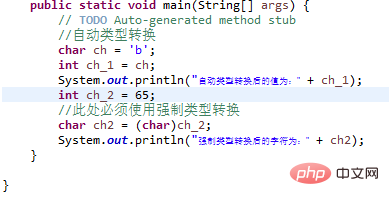

1. Automatic type conversion
Integer, real (constant), and character data can be mixed for operations. During the operation, different types of data are first converted into the same type, and then the operation is performed.
Data type conversion must meet the following rules:
1. Type conversion cannot be performed on boolean type.
2. Object types cannot be converted into objects of unrelated classes.
3. Forced type conversion must be used when converting a large-capacity type into a small-capacity type.
(Video tutorial recommendation: java video)
4. The conversion process may cause overflow or loss of precision, for example:
int i =128; byte b = (byte)i;
because of the byte type It is 8 bits, and the maximum value is 127, so when int is cast to byte type, a value of 128 will cause overflow.
5. The conversion of floating point numbers to integers is obtained by discarding decimals instead of rounding, for example:
(int)23.7 == 23; (int)-45.89f == -45
Note: The number of digits of the data type before conversion must be low. to the converted data type.
2. Forced type conversion
1. The condition is that the converted data types must be compatible.
2. Format: (type) value type is the data type to be forced to type conversion.
Let’s look at the following example:

The output result is:

3. Implicit forced type conversion
1. The default type of integer is int.
2. This situation does not exist for floating point types, because when defining the float type, F or f must be followed by the number.
Recommended tutorial: Getting started with java development
The above is the detailed content of Introduction to java type conversion and its rules. For more information, please follow other related articles on the PHP Chinese website!